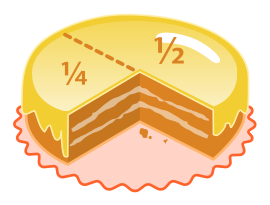I think fractions are important to understand and kids as young as kindergarten can get the basic idea of fractions. My god-daughter is five and she is so excited to go to kindergarten this fall. I tricked her with a fraction question yesterday. We were having cake at a baby shower and I asked her if she wanted 1/2 or 1/3 of a piece of cake. She said 1/3 and I asked her why, she said because 3 is bigger than 2. I took a minute to draw her a picture of a cake, divided it into 2 pieces and then I drew another picture of a cake divided into thirds. Once she saw the picture she giggled and said, "I want that piece" which was the 1/2 piece not the 1/3 piece.
We all had whole pieces of cake but talking about fractions with a kindergartner was enlightening. My friends and family are not surprised by my random math tangents anymore. Taking math classes this summer has provided many teachable moments for me and my family. Math is all around us and whether it is cooking, shopping, saving, sharing or measuring it is important to have basic math skills. We could have some funny tasting cookies if the recipe was not tripled or doubled correctly.

Here's a fun fractions jeopardy game to try with a class. You can have teams and ring in when someone has the answer.
Check out this site for more on fractions.